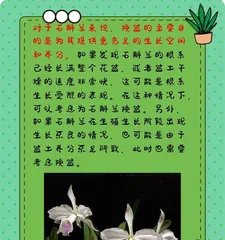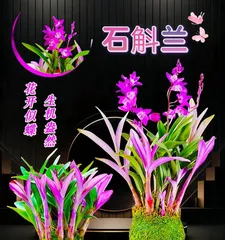Dendrobium is a famous traditional Chinese medicine with high medicinal value. It can not only be used as medicine to treat diseases, but also cultivated as a horticultural plant. However, in the process of Dendrobium cultivation, selecting the right potting soil and pot type is crucial for the plant's growth and development. Should we use a large pot or a small pot to care for Dendrobium?

I. Advantages of Large Pots
1.1 Large pots have a large capacity and can provide more nutrients and water, which is beneficial for plant growth;
1.2 The roots in large pots can develop and expand better, which is conducive to the stable growth of the plant;

1.3 Large pots hold more soil, which helps maintain better soil moisture and temperature, beneficial for the care of Dendrobium plants;
1.4 Large pots are relatively stable and less susceptible to interference from the external environment, helping to maintain the plant's growth rhythm.
II. Advantages of Small Pots
2.1 Small pots are smaller in volume, easy to move and manage, making them convenient for maintenance;

2.2 Root development in small pots is limited, which can effectively control the plant's growth rate, beneficial for maintaining the plant's health;
2.3 Small pots contain less soil, which is beneficial for drainage and ventilation, preventing the soil from becoming too wet, too hot, or from fostering pests and diseases;
2.4 Small pots allow for better control of nutrient supply and irrigation frequency, avoiding over-fertilization or over-watering.
III. How to Choose the Right Pot Type
3.1 Factors to consider in Dendrobium care include sunlight, humidity, temperature, ventilation, etc.;
3.2 When choosing a pot type, a comprehensive consideration should be given to different environmental factors and plant characteristics;
3.3 If the environmental conditions are not ideal, a more stable large pot can be chosen to ensure the stability of plant care;
3.4 If the environmental conditions are good, a relatively small pot can be chosen, which is beneficial for the control and management of the plant.
IV. How to Choose the Right Potting Soil
4.1 Dendrobium cultivation requires the use of nutrient-rich soil with high organic matter content;
4.2 The potting soil should have good air permeability, water retention, and ventilation;
4.3 The pH value of the potting soil should be between 6.0-7.0, which is beneficial for plant growth;
4.4 It is not recommended to use cheap, low-quality potting soil to avoid affecting the healthy growth of the plant.
V. How to Control Irrigation and Fertilization
5.1 In Dendrobium care, irrigation and fertilization are key factors;
5.2 Each watering should mainly aim to maintain the moisture of the potting soil, avoiding over-watering;
5.3 Fertilization should be carried out according to the plant's growth rhythm and nutritional needs, avoiding excessive fertilization;
5.4 Over-watering and over-fertilization can lead to overly wet potting soil, causing problems such as pests, diseases, or root rot.
VI. How to Prune and Provide Support
6.1 Dendrobium grows fast and requires regular pruning and shaping;
6.2 Pruning can promote the growth of branches and flower buds, which is beneficial for the plant's aesthetic appearance and healthy growth;
6.3 Support can prevent the plant from tilting and breaking, which is beneficial for its stable growth;
6.4 Pay attention to the appropriateness of the pruning and support to avoid affecting the plant's growth.
VII. How to Prevent and Control Pests and Diseases
7.1 Dendrobium is susceptible to pests and diseases such as aphids, powdery mildew, and black spot;
7.2 Methods for preventing and controlling pests and diseases include physical, biological, and chemical control;
7.3 Physical control includes methods such as manual capture, spraying clean water, and dust removal;
7.4 For chemical control, non-toxic and environmentally friendly green control agents should be chosen to avoid polluting the plant and the environment.
VIII. How to Provide Nutritional Supplements
8.1 The growth of Dendrobium requires nutritional supplements of various elements;
8.2 Nutritional supplements should be provided according to the plant's nutritional needs and growth rhythm;
8.3 Nutritional supplements can be provided using methods such as organic fertilizers, compound fertilizers, or water-soluble fertilizers;
8.4 Nutritional supplements should be moderate, balanced, and stable to avoid excessive nourishment.
Caring for Dendrobium requires considering many factors, including the environment, potting soil, irrigation, fertilization, pruning, support, pest and disease control, and nutritional supplements. When choosing a pot type, it should be selected based on different circumstances, as large and small pots each have their own advantages and disadvantages. Whether using a large or small pot, attention to detail is necessary for the healthy growth of Dendrobium.